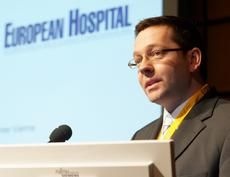"Every investment must be reviewed and revised very closely"
Finance Section
André Hoppen, Sales Manager VR Medico, Berlin, Germany, kicked off the finance item at the HMS agenda with his lecture “Do you know the right financing strategy for your hospital?”

Finance
Leasing medical equipment is now possible almost everywhere, enabling hospitals to invest in modern technology, keeping liquidity and having full flexibility. But what does that mean in reality? As a basic principle, leasing is the temporary use of equipment such as ultrasound, CT or any other mobile goods for monthly rent. When a hospital decides to lease a product, the leasing company enters into a commercial commitment with the dealer or manufacturer. After taking charge of the goods, the leasing company pays the negotiated price between the customer and dealer and the hospital pays the monthly rate. This is called the „leasing triangle“.
Due to local GAAP, US GAAP and IFRS there is a need to differentiate between real operational leasing, off balance leasing and financial leasing. Off-Balance leasing, according to US GAAP and IFRS, means very short time use of the equipment – maximum is 5-6 years for high end and 2-3 years for low end equipment, including full service manufacturer contract. After this period, the equipment is sold as 'used' on the market or sold back to the manufacturer or any other dealer.
The second possiblity is financial leasing. At least 95 % of contracts fall into this group. All typs of contracts can be found in this section; for example, full payout lease, part payout lease with terminal value and contracts with the possibility to terminate at any time. At the end of one of these contracts, termed the end of lease, there is often the possibility to decide what should be done with the equipment: you can either buy it, lengthen the contract or give the device back. One indicator of the quality of a leasing group is what they do at the end of their contract, Hoppen pointed out. Hospital managers should ask this, every time they discuss leasing. „And never forget – leasing is not a glamour box, it is simply an alternative to traditional credit. It's not more expensive nor cheaper“, he advised the audience.
In his lecture „Investment strategies and financing solutions in healthcare projects“ Vasco Luis José de Mello MBA, Executive Director of Grupo Hospitalario, Madrid, noted the significant role technology plays in healthcare investments– otherwise hospitals can neither attract the best physicians nor practice the best diagnostics. But in times of financial pressure on public and private budgets, every investment must be reviewed and revised very closely according to its necessity. To be able to run a business with minimum capital invested and therefore maximize the return on capital employed (the so-called „capital light stragtegy“ to minimize direct investment), the main questions should be: Is this investment really needed? If so: How do I pay for it?„ Think of the future and consider the best solution from several perspectives, which will not always match that of a strict financial point of view. This consideration may lead to further questions, opening up new new financial solutions: Do I really need to manage the area or service by myself? The answer always depend on the nature of the need, but often the first thought is to outsource, de Mello said. Investment in outsourcing cannot be avoided but it's important to think of all areas and services including the less common, such as sterilization, imaging area, nuclear medicine or pharmacy. Third party investors could diminish the need for equipment by between 10 % and 60 %, including imaging, laboratories and dialysis etc. Handing responsibility to suppliers can reduce the need for further investment in equipment.
Another question is: Do I need to own any equipment at all? The answer depends. For a single purpose project, the establishment of Joint Ventures could be wise. Furthermore, all assets not connected with core business should be sold, de Mello advised. To explain his idea, he gave different examples based on a real case of a Spanish hospital. The most unusual case was where the whole hospital building was sold to reduce the leverage of the Balance Sheet. „There are a lot of hospitals talking about it,“ he said „but only a few really do it. But it is a worthwhile consideration, for 25 % of costs for a hospital are for land and 45 % are for the building (the rest are 10 % working capital and 20 % equipment).“ One solution is the sale and lease-back for the existing buildings, or funding of green field projects. The contract period runs 15 to 20 years, while the rent increases with inflation. The hospital retains the right of final refusal at the end.
Finally, de Mello gave the audience three points of advice for investment decisions:
1.Minimize direct investment (Capital Light Strategy)
2.Promote collaborative partnership to minimize risk, to share investment and bring funding
1.Focus on cash inflows
09.03.2009











